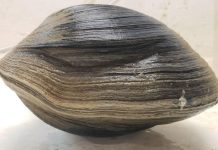
May 1 (UPI) — Researchers have discovered a new invasive clam in the Illinois River.
Scientists discovered the new clam while searching for the scaleshell, Leptodea leptodon, an endangered species of freshwater mussel. Instead, researchers noticed a type of clam distinct from other invasive species.
Researchers determined the clam belonged to the Corbicula genus, a group of invasive clams native to Asia. Corbicula clams were first brought to North America in the early 20th century, most likely by Asian immigrants. They were first observed in Vancouver, British Columbia, in 1924.
Lab tests confirmed the new clam’s genetic and physical distinctiveness, but scientists aren’t sure if the clam is a new species or simply a new form.
The reproductive strategies of Corbicula clams make the bivalves hard to classify.
“When the sperm fertilizes the egg, it kicks out the maternal nuclear DNA, retaining only the male’s, and thus producing clones of the father,” Jeremy Tiemann, an aquatic ecologist at the University of Illinois, said in a news release. “These offspring, however, retain the mother’s mitochondrial DNA, which resides in tiny organelles outside the nucleus.”
The clams also regularly hybridize, further complicating the task of classification.
“To compound matters even more, Corbicula can also be hermaphrodites, so they can fertilize themselves,” Tiemann said. “This means that it takes only a single clam to spawn a new population.”
Different genetic measurements can yield conflicting tales of clam’s origins. Researchers use the word “form” to differentiate between Corbicula taxa.
Researchers haven’t yet analyzed the clam’s ecological impact, but the presence of the new organism — whether a species or form — is likely bad news for native species like the scaleshell.
“If past invasions are any indication, it may signal further erosion of ecosystem services traditionally provided by watersheds already impacted by Corbicula,” Tiemann said.
Researchers described their discovery in the journal BioInvasions Records.





